Dredge #8 is located near the path of the Alaskan Pipeline and there was an exhibit in the area where we waited for the train to take us out to the dredge site.
When the pipeline is above ground, as it is here, it rests on these "H" shaped supports. In this way, during an earthquake, the pipeline will flex.
Frederick in the pipeline in front of the "pig", a pipe-cleaning device.
Along the way to the dredge, there were demonstrations of how small scale gold prospecting was done. In the winter, the miners would dig, thawing the ground/permafrost as they dug down to bedrock where the gold has settled. As they dug along the bedrock, called drifting, they would bring up loads of dirt that contained the gold.
This dirt/gravel was piled up next to the shaft, the pay-dirt, and in warmer weather the miners would use a rocker-box to wash the gravel in such a way as to separate heavy gold from the lighter sands and gravel.
The Dredge first required large amounts of organic overburden to be removed then the underlying gravels close to bedrock had to be thawed. It would take five years to prepare the area for the dredge to do its work.
This is the front of the dredge and you may notice the bucket-line that would dig into the bank, scooping up loads of gold-bearing gravel, then haul each bucket load into the dredge where a downward sloping cylinder, perforated with a series of small holes of varying sizes, would turn under water pressure and the heavy pieces of gold would fall through the holes into sluice boxes below, trapping the gold.
We were each given a poke, a small bag of pay dirt, and a pan to try our luck.
We each retrieved flakes of gold and...
took it to be weighed and valued.
Frederick found flakes with a value of $33 and I found $36 worth of flakes that we had placed into lockets attached to rings that can be used to identify wine glasses. When we drink wine again, we will be able to make use of the blue beaded one to mark my glass and the red beaded one for Frederick's.
On display was a 19 ounce nugget of gold, about 4 inches long, the 25th largest nugget ever found, in 1995, in the interior Alaskan Gold Fields.
This is Earl Hughes who entertained us on the little train that carried us out to the main camp and...
George Peterson was our costumed interpreter.
On the way back into Fairbanks, we stopped at the Fountainhead Antique Auto Museum and were impressed at the show-quality antique cars on display.
In addition to the automobiles, there were museum-quality displays of clothing, mostly women's dresses, that corresponded to the era of the cars.
We enjoyed the opportunity to try on some of the clothing and...
pose in an antique car.
There were also other interesting items such as these willow chairs that look as if they are still growing!
Tonight the Caravan went to the local Pioneer village for a salmon/prime rib dinner and a show.
The show was a light-hearted musical on the founding of Fairbanks.
The cast.


































No comments:
Post a Comment